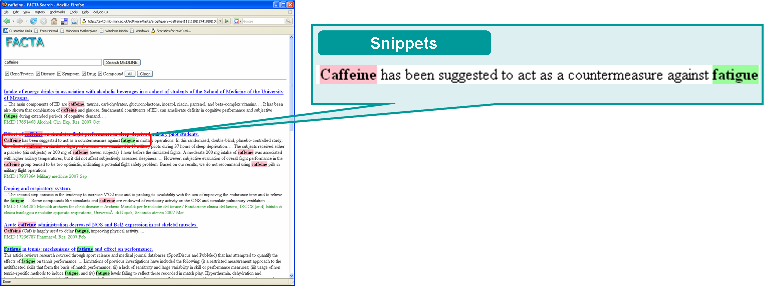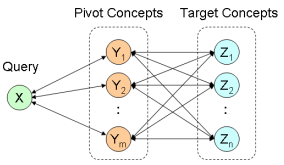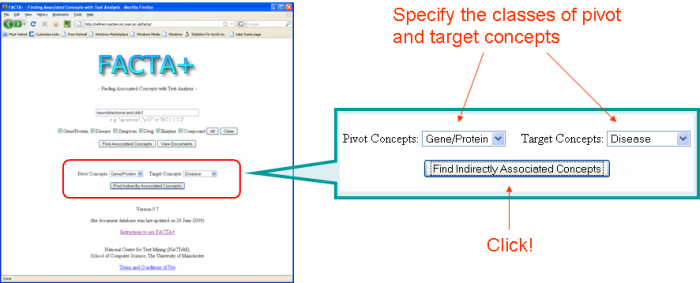Type a query in the text box and press the "Find Relevant Concepts" button. A query can be an arbitrary word (e.g. "p53"), or a concept ID (e.g. "UNIPROT:P04637"). The types of concept IDs that are accepted by the system are given in Appendix A. Queries can include AND or OR as boolean operators. A query that contains several different operators needs round brackets to resolve ambiguities [e.g. "(UNIPROT:P04637 AND (lung OR gastric))"]. The AND operator can be omitted (e.g. "p53 blood" and "p53 AND blood" are equivalent).

FACTA+ then retrieves the documents that match the query from MEDLINE. The concepts mentioned in the retrieved documents are counted and ranked according to their relevance to the query. The results are presented in a tabular format. You can choose a different ranking scheme by clicking a link just above the table. Currently, FACTA+ supports the following three ranking criteria: frequency, pointwise mutual informaition, symmetric conditional probability.

By clicking a document icon next to a concept name in the table, you can then view snippets that describe the association.

Another piece of functionality of FACTA+ is to help you find concepts that are indirectly associated with the query. The idea is to combine multiple direct associations to retrieve concepts whose associations with the query are not obvious. (see the figure below).

All you need to do is: (1) specify the category of target concepts (the ones that you are are interested in as the final outcome), (2) specify the category of pivot concepts (the ones that interlink your query and the target concepts), and (3) press the "Find Indirectly Associated Concepts" button.

FACTA+ then produces a ranked list of target concepts together with the informaton about how they are associated with your query. The target concepts are ranked based on their "expected information" (the first column in the table), where the "information" (the second column) represents how surprising the association is in terms of direct co-occurrence statistics. The values shown in the fourth and sixth colums are the strengths of associations between the target and pivot concepts, and the pivot concepts and the query, respectively. You can also see textual evidence (snippets) of those associations by clicking them.

| Concept Type | Format | Example of concept ID |
|---|---|---|
| Human Gene/Protein | UNIPROT:* | UNIPROT:P04637 |
| Disease/Symptom | UMLS:* | UMLS:C0011849 |
| Drug | KEGG:* | KEGG:D02118 |
| Enzyme | EC:*.*.*.* | EC:3.4.23.15 |
| Chemical compound | CAS:*-*-* | CAS:7782-44-7 |
| Biomolecular events | GENIA:* (see below for the full list) | GENIA:Gene_expression |
The table below shows the full list of concept IDs for the biomolecular events that are currently recognized by FACTA+. These are the event types defined in the BioNLP'09 shared task.
| Concept ID | Description |
|---|---|
| GENIA:Gene_expression | Biomolecular events related to protein production and breakdown |
| GENIA:Transcription | |
| GENIA:Protein_catabolism | |
| GENIA:Localization | A change of the location or presence of a protein |
| GENIA:Binding | Binding of two or more proteins (including homodimerization); binding of a protein and DNA |
| GENIA:Phosphorylation | Addition of a phosphate group to a protein or other organic molecule |
| GENIA:Regulation | Regulatory or causal relations between events and proteins |
| GENIA:Positive_regulation | |
| GENIA:Negative_regulation |